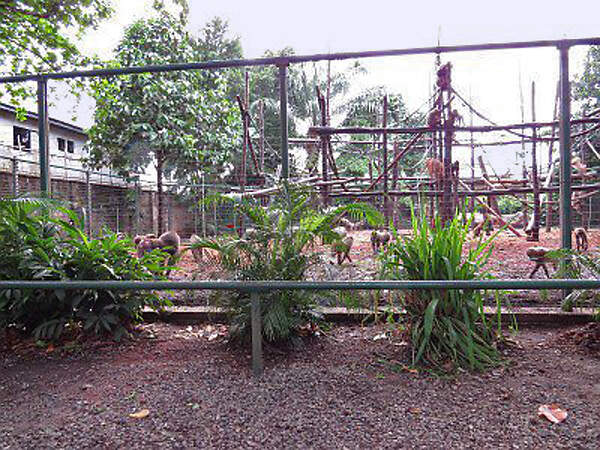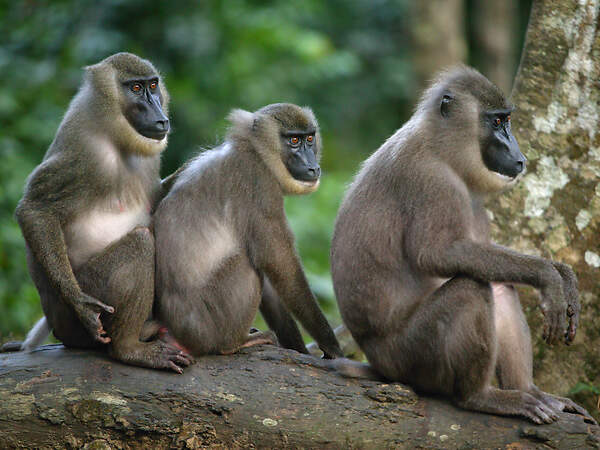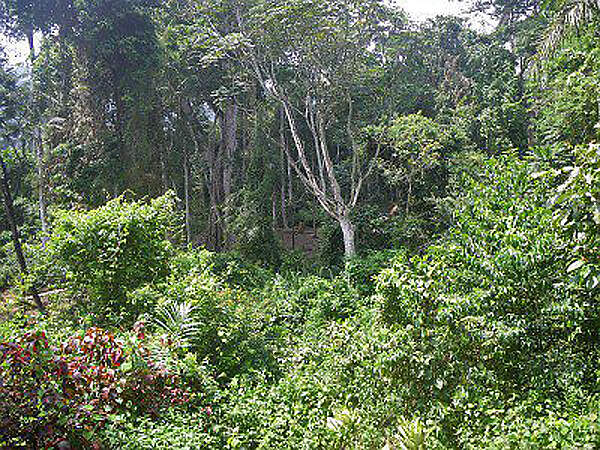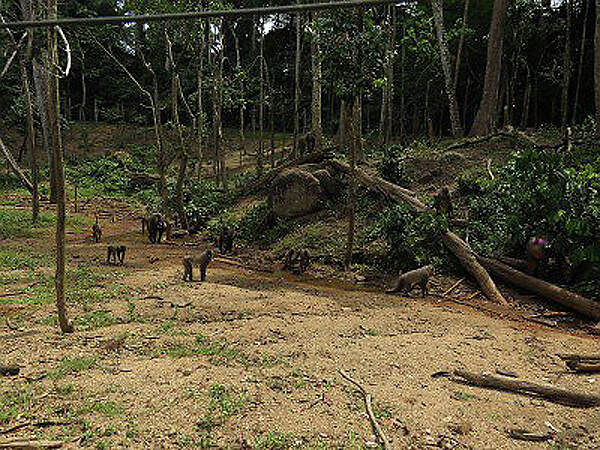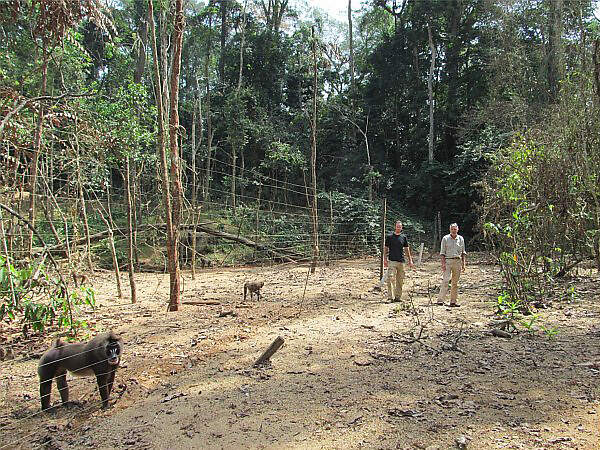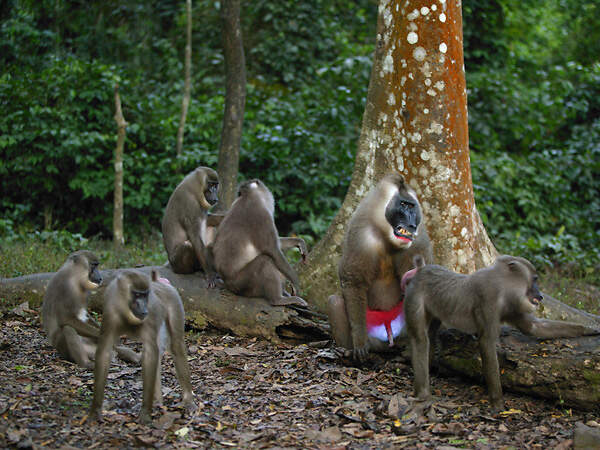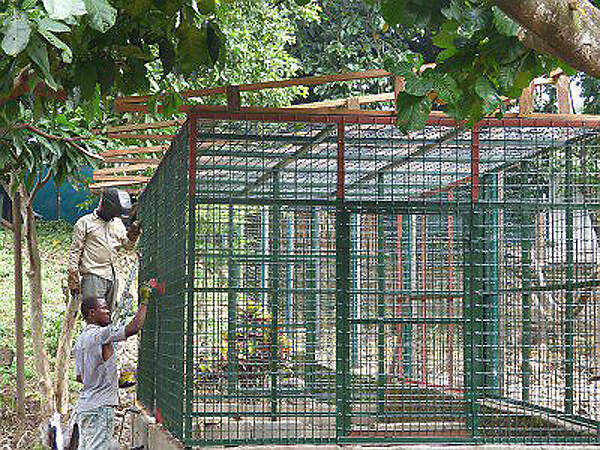Rettet den Drill
Rettet den Drill in Kamerun und Nigeria
ErlebnisZoo Hannover, Tierpark Hellabrunn München, Tierpark Nordhorn, Wilhelma Stuttgart, Zooverein Wuppertal
|
|
Ausgehend von der “Aktion Rettet den Drill", die ein ehemaliger Tierpfleger aus dem ErlebnisZoo Hannover bereits 1988 gegründet hatte, entstand am 17. Januar 2004 im Tierpark Nordhorn der Verein “Rettet den Drill”, dessen Geschäftsstelle sich nach wie vor in Nordhorn befindet. Der Tierpark Nordhorn, der als einziges institutionelles Mitglied selber gar keine Drills hält, unterstützt den Verein vor allem personell (Buchhaltung, Kassenwartin / Vorstandsarbeit) aber auch durch die Übernahme diverser Briefsendungen sowie regelmäßige Geldspenden. Zu den institutionellen Mitgliedern gehören ferner der Tierpark Hellabrunn, der auch das Europäische Erhaltungszuchtprogramm (EEP) für den Drill koordiniert sowie das Internationale Zuchtbuch (ISB) für diese Affenart führt, und der Erlebnis-Zoo Hannover. Auch diese beiden Zoos unterstützen durch Sach- und Finanzspenden über die Mitgliedschaft hinaus die Arbeit des Vereins. Unter den mittlerweile über 100 Einzelmitgliedern befindet sich mindestens ein Tierpfleger aus jedem Drill haltenden Zoo Deutschlands.Ferner sind auch Biologen, Kuratoren und Tierärzte aus verschiedenen Zoos Mitglieder im Verein. Nicht zu unterschätzen ist jedoch der Anteil der Drill-Freunde, die nicht in Zoos arbeiten und dennoch großzügig Geld spenden und die Vereinsarbeit intensiv verfolgen. Unterstützt wird „Rettet den Drill“ e.V. unter anderem regelmäßig vom Berufsverband der Zootierpfleger, dem Zooverein Wuppertal, den Zoofreunden Hannover, den Freunden und Förderern der Wilhelma Stuttgart-Bad Cannstatt sowie der Stuttgarter Wilhelma. Ein Hauptzweck des Vereins ist es, die von der Organisation PANDRILLUS in Nigeria und Kamerun betriebenen Schutzprojekte kontinuierlich zu unterstützen. Bis 2014 wurde eine Gesamtsumme von über 50 000 Euro an die Projekte überwiesen und auch etliche Sachspenden haben nach viel Arbeit und hohem persönlichen Engagement den Weg nach Afrika gefunden. Besonders zu erwähnen ist in diesem Zusammenhang die vom Erlebnis-Zoo Hannover gespendete Arbeitskleidung, die nach jahrelanger Lagerung, Sortierung und Verpackung im Tierpark Nordhorn dann endlich 2012 in Nigeria ankam. Heute wird sie in Westafrika überall gern von den Pflegern getragen. Allein dieser Transport hat den Verein insgesamt 5 Jahre intensiven Bemühens gekostet bis es gelang die über 850 kg Kleidung von verschiedenen Transportunternehmen unentgeltlich nach Nigeria transportieren zu lassen. Die von einem amerikanischen Biologenpaar gegründete Organisation PANDRILLUS betreibt seit 1991 die Drill Ranch, eine Schutzstation in Calabar, Nigeria sowie seit 1993 das Limbe Wildlife Center in Kamerun. In Nigeria erfolgte 1996 mit der Drill Ranch in den Afi-Bergen noch der Aufbau einer Art „Außenstation“ von Calabar. In diesen drei Stationen lebten 2014, bei einem geschätzten Wildbestand von nur noch etwa 3000 Tieren, insgesamt über 520 Drills. Dabei handelt es sich vielfach um beschlagnahmte Tiere. Also Jungtiere, die Wilderer nicht töten sondern als Haustier halten oder verkaufen. Wenn eine solche illegale private Haltung den Behörden bekannt wird, so ziehen sie die Tiere ein und diese kommen dann nach Calabar oder in das Limbe Wildlife Center. Keines der Tiere wurde je angekauft, um den illegalen Handel nicht zu fördern. Neu angekommene Drills werden drei Monate lang in kleinen Gruppen von 3 - 6 Tieren in Quarantäne gehalten, dort sehr gründlich untersucht und nach Bedarf tierärztlich versorgt oder aufgepäppelt. Danach werden sie zu großen sozialen Zuchtgruppen zusammengewöhnt mit dem langfristigen Ziel, sie wieder in geschützten Gebieten ihres natürlichen Lebensraumes auszuwildern, sofern sie sich dafür eignen. Die Tiere in Calabar können besipielsweise nicht mehr ausgewildert werden. Sie sind von klein auf viel zu sehr an den Menschen gewöhnt und werden als „education group“ zur Information und Aufklärung der Bevölkerung eingesetzt, insbesondere um die „Bushmeat“-Problematik anzusprechen. Die Gelder, die der Verein „Rettet den Drill“ e.V. 2013/2014 nach Nigeria überwiesen hat wurden vor allem für den Wideraufbau der Gehege in den Afi-Bergen nach einer schweren Unwetterkatastrophe sowie für Futterkosten dort benötigt. Ein Großteil dieser Gelder stammte aus Stuttgart (Stuttgarter Wilhelma sowie Freunde und Förderer der Wilhelma Stuttgart-Bad Cannstatt). Im Limbe Wildlife Center, wo mittlerweile über 100 Drills gehalten werden, mussten neue Abtrenn-/Eingewöhnungsgehege gebaut werden Diese, sowie spezielle Futterkosten für die Drills konnten 2014 durch eine großzügige Spende des Zoovereins Wuppertal von über 5.000€ finanziert werden. Von 2006-2022 stellte der Verein "Rettet den Drill" insgesamt 450'000 Euro für den Schutz und die Erhaltung des Drills zur Verfügung. 2022 konnte in den Afi Mountains eine mit Spenden des Zoo-Vereins Wuppertal e.V. und der Gemeinschaft der Zooförderer e.V. finanzierte Veterinärstation gebaut werden. Für das "Green Project", dem Anbau von Futterpflanzen für das Limbe Wildlife Center durch ehemalige Wilderer stellte der Tierpark Hellabrunn 5'000 € zur Verfügung. Auf der Drill Ranch in Calabar und in den großen, naturnahen Anlagen in den Afi Mountains lebten 2022 insgesamt etwa 620 Drills, im Limbe Wildlife Center weitere 62.
|
Literatur und Internetquellen:
- DRILL INFO, Ausgabe 17, Januar 2014
- DRILL INFO, Ausgabe 18, Juni 2014, Jubiläumsausgabe
- DRILL INFO 33, Juli 2022
DRILL INFO 34, Dezember 2022 - Pers. Mitteilungen von Dr. Heike Weber (Kassenwartin) und Kathrin Paulsen (1. Vorsitzende) vom Verein „Rettet den Drill“ e.V.
- www.rettet-den-drill.de (hier auch weiterführende Links)
Tierart-Datenblatt: Drill (Mandrillus leucophaeus)
Lebensraum: Zentralafrikanischer Regenwald
Zurück zu Übersicht Spitzhörnchen, Halbaffen und Affen
Zurück zu Drill (Mandrillus leucophaeus)
Weiter zu Mandrill (Mandrillus sphinx)
KINGDON, J., HAPPOLD, D., BUTYNSKI, T. HOFFMANN, M., HAPPOLD, M., KALINA, J. (Hrsg. 2013)
Mammals of Africa.
6 Bände, 3500 Seiten. Bloomsbury Publishing. ISBN 9781408122570.
Mammals of Africa (MoA) is a series of six volumes which describes, in detail, every currently recognized species of African land mammal. This is the first time that such extensive coverage has ever been attempted, and the volumes incorporate the very latest information and detailed discussion of the morphology, distribution, biology and evolution (including reference to fossil and molecular data) of Africa's mammals. With 1,160 species and 16 orders, Africa has the greatest diversity and abundance of mammals in the world. The reasons for this and the mechanisms behind their evolution are given special attention in the series.
Each volume follows the same format, with detailed profiles of every species and higher taxa. The series includes some 660 colour illustrations by Jonathan Kingdon and his many drawings highlight details of morphology and behaviour of the species concerned. Diagrams, schematic details and line drawings of skulls and jaws are by Jonathan Kingdon and Meredith Happold. Every species also includes a detailed distribution map. Extensive references alert readers to more detailed information.
Volume I: Introductory Chapters and Afrotheria (352 pages)
Volume II: Primates (560 pages)
Volume III: Rodents, Hares and Rabbits (784 pages)
Volume IV: Hedgehogs, Shrews and Bats (800 pages)
Volume V: Carnivores, Pangolins, Equids and Rhinoceroses (560 pages)
Volume VI: Pigs, Hippopotamuses, Chevrotain, Giraffes, Deer and Bovids (704 pages)
Geflecktes Rüsselhündchen (Rhynchocyon cirnei)
Band I: 285-286.
kingdon-biblio
ALPERS, D.L., VAN VUUREN, B.J., ARCTANDER, P. & ROBINSON, T.J. (2004)
Population genetics of the roan antelope (Hippotragus equinus ) with suggestions for conservation.
Mol Ecol. 2004 Jul;13(7):1771-84.
Abstract:
The roan antelope (Hippotragus equinus) is the second largest African antelope, distributed throughout the continent in sub-Saharan savannah habitat. Mitochondrial DNA (mtDNA) control region sequencing (401 bp, n = 137) and microsatellite genotyping (eight loci, n = 137) were used to quantify the genetic variability within and among 18 populations of this species. The within-population diversity was low to moderate with an average mtDNA nucleotide diversity of 1.9% and average expected heterozygosity with the microsatellites of 46%, but significant differences were found among populations with both the mtDNA and microsatellite data. Different levels of genetic resolution were found using the two marker sets, but both lent strong support for the separation of West African populations (samples from Benin, Senegal and Ghana) from the remainder of the populations studied across the African continent. Mismatch distribution analyses revealed possible past refugia for roan in the west and east of Africa. The West African populations could be recognized together as an evolutionarily significant unit (ESU), referable to the subspecies H. e. koba. Samples from the rest of the continent constituted a geographically more diverse assemblage with genetic associations not strictly corresponding to the other recognized subspecies.
alpers-biblio
EAST, R. (1988-1990)
Antelopes: Global Survey and Regional Action Plans.
Part 1: East and Northeast Africa (1988). 7 Kapitel, 5 Länder, 96 Seiten, mit Verbreitungskarten.ISBN 2-88032-942-6.
Part 2: Southern and South-Central Africa. 8 Kapitel, 6 Länder, 96 Seiten, mit Verbreitungskarten.ISBN 2-88032-970-1.
Part 3: West and Central Africa. 16 Kapitel, 14 Länder, 171 Seiten, mit Verbreitungskarten. ISBN 2-8317-0016-7.
IUCN-SSC Antelope Specialist Group. IUCN, Gland.
east-biblio
HAPPOLD, D.C.D. (1987)
The Mammals of Nigeria.
402 Seiten, 20 Bildtafeln mit 2/w-Photos, zahlreiche Strichzeichungen.
Oxford University Press. Oxford, New York, Toronto.
ISBN 0-19-8575653.
Anbietertext:
Both a field guide and a reference work, this book is the first comprehensive account of all 250 species of mammals recorded in Nigeria. The first part describes each species in detail with information on distribution, identification, status, ecology, reproduction, and taxonomy, with keys provided for easy identification of each species. Following chapters consider the ecological relationships of Nigerian mammals, zoogeographical patterns and ecological trends, and interactions between humans and mammals. Written with a minimum of technical terms and filled with photographs, drawings, and maps, this book is a fascinating and useful work for anyone intererested in African mammals.
happold-biblio
WILLIAMS, J. G. & ARLOTT, N. (1980)
A Field Guide to the Birds of East Africa.
415 Seiten, über 650 Abbildungen auf 48 Farbtafeln.
Collins, London. ISBN 13: 9780002191791.
Inhalt:
Identifies more than a thousand species of birds and provides information on the range, habitat, voice, and characteristics of each bird.
williams-biblio
WEINSHEIMER, F., M. FLECKS, W. BÖHME & D. RÖDDER (2010)
Projektvorstellung - Die Herpetofauna des Kimboza Forest in Tansania unter besonderer Berücksichtigung des Türkisen Zwerggeckos Lygodactylus williamsi: Populationsabschätzung und Verbreitungsstudie eines bedrohten Endemits.
Elaphe 1: 17-20.
weinsheimer-biblio
03.04.2013 - 1'925
EATON, M.J. (2010)
Dwarf Crocodile - Osteolaemus tetraspis.
In: Crocodiles.Status Survey and Conservation Action Plan: 127-132.
Third Edition, ed. by S.C. Manolis and C. Stevenson. Crocodile Specialist Group: Darwin.
Aus dem Inhalt:
The African dwarf crocodile historically ranged throughout the lowland regions of West and western Central Africa, from Senegal and The Gambia in the west to the eastern border of the Congo Basin in the Democratic Republic of Congo and Uganda. Northern Nigeria and Cabinda Province (Angola) are considered to be the northern and southern extents of the genus, respectively. The Central and West African dwarf crocodile (O. tetraspis) is now distinguished from Osborn’s dwarf crocodile (O. osborni), and new research suggests that populations further west are signifi cantly differentiated from lineages in Central Africa and the Congo Basin and warrant a unique species designation (Osteolaemus cf. tetraspis) (Eaton et al. 2009).
The taxonomy of the African dwarf crocodile has been under debate for almost 80 years. Osteolaemus tetraspis was first described in 1860 from Gabon. A second morphological form, discovered in the upper Congo River Basin, was described as a new genus (Osteoblepharon osborni, Schmidt 1919). This new genus was subsequently considered to be unwarranted, resulting first in osborni being relegated as species of Osteolaemus and then to a subspecies, Osteolaemus tetraspis osborni (Wermuth 1953). Some authorities have even suggested that sub-species status may not be merited. A recent morphological study, however, has confirmed fixed differences between tetraspis and osborni, suggesting that each should be resurrected as a distinct taxon. Additionally, a recent molecular phylogenetic analysis of samples collected from the Republic of Congo, Gabon, Ivory Coast and Ghana supports the evolutionary distinctiveness of dwarf crocodiles in the Congo Basin (osborni) from those further west. This same investigation also revealed that the nominal form of O. tetraspis from Gabon’s Ogooué Basin is genetically distinct from dwarf crocodiles in West Africa, suggesting that at least one new morphologically cryptic species exists in the latter region.
WINEMILLER, K.O. & KELSO-WINEMILLER, L. C. (1994)
Comparative ecology of the African pike, Hepsetus odoe, and tigerfish, Hydrocynus forskahlii, in the Zambezi River floodplain.
Journal of Fish Biology 45 (2): 211–225, August 1994. DOI: 10.1111/j.1095-8649.1994.tb01301.x
Abstract:
The ecology of sympatric African pike, Hepsetus odoe (Hepsetidae), and tiger fish, Hydrocynus forskahlii (Characidae), were compared during high (May-August) and falling water (September-December) conditions in the Upper Zambezi R. drainage of Zambia. Both species were common in the central and southern regions of the river and associated floodplain, and Hydrocynus was common in the northern region in swift flowing tributaries where Hepsetus was rare. Hepsetus inhabited vegetated environments of river backwaters, lagoons, and sluggish tributaries, whereas Hydrocynus occupied the open water of the main river channel almost exclusively. During the period of annual flooding, juveniles of both species coexist in flooded savanna regions. Size distributions of adult Hydrocynus and Hepsetus changed relatively little between high and low water conditions. Stomach contents analysis indicated that adult size classes of both species are almost entirely piscivorous, and both show diet shifts with changes in size. Only very small seasonal diet shifts were noted. Approximately 50% of the diet of Hepsetus consisted of haplochromine cichlid fishes, but also included large numbers of tilapine cichlids and mormyrids, Hydrocynus consumed primarily cichlid fishes, but also consumed large percentages of Hepsetus and small characid fishes. Small size classes of Hepsetus fed heavily on small machokid catfishes (Synadontis spp.) and later shifted to a diet of cichlids and mormyrids, and small Hydrocynus preyed heavily on Barbus spp. (Cyprinidae), small characids, and mormyrids. Ratios of prey length-predator length averaged approximately 0·26 for Hydrocynus and nearly 0·40 for Hepsetus. The large potential for food resource competition appears not to be realized due to a very high degree of habitat partitioning between larger size classes of the two species. At the interface between river backwaters and channel habitats, Hydrocynus is a significant predator of Hepsetus, a factor that should further restrict the occurrence of the latter in open areas of the main channel.
WILLIAMS, J. G. (1981)
A Field Guide to the National Parks of East Africa.
Collins, London.ISBN 0 00219215 2
Anbieter-Text:
Brown hardback covers in pict d/w. 350 pps. This scarce book gives locations & Brief descriptions of all game reserves & Sanctuaries of Kenya, Uganda & Tanzania. Illustrated with maps; Lists of the principal mammals & all birds to be found in each. The line-drawings and paintings of over 300 mammals and birds, 191 in colour, are the work of Rena Fennessy. Large index at the back.

